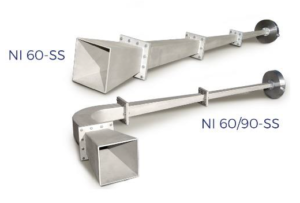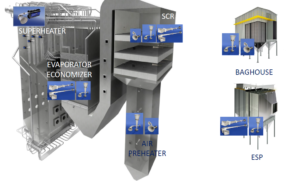The Nirafon® process of sound clening keeps the super heaters, economisers, air preheaters, flues, filters and fans of the boiler plants clean and prevents vaulting of particles in the silos and cyclones. Options for air-driven acoustic cleaners
The sound cleaning can be divided into two according to the temperature:
- For temperature till 1000°C :
– Nirafon® 250-SS i 250/90-SS

– Nirafon® 100-SS i 100/90-SS

– Nirafon® 60-SS i 60/90-SS

- for temperature more than 1000°C

– Sound clening- how it works?



The accumulation of ash and other combustion residues on the structures of boilers is a familiar but annoying problem at power and heating plants. Energy and process industries use acoustic cleaners for cleaning different surfaces inside the plants. The method works best for removing powder type materials from surfaces without interrupting the process, but can also be used in cases where the ash sticking to surfaces becomes hard or even when the ash is partly in molten form.
Acoustic Cleaning System consists of sound emitters best suited to different conditions and an automatic control system. The frame, the cover and the membrane form the sound generator unit of Nirafon® pneumatic acoustic cleaner. The membrane inside the sound generator works as a valve, loaded by pre-tensioning of the frame and the cover, compressed air, the acoustic impedance of the horn, and the spring back factor, formed by the air space on the other side of the membrane. The horn is an acoustic wave guide, of which cross-section changes continuously. The design of the horn effects the frequency division of the created sound. When the air column inside the horn is made to oscillate, its oscillation frequency will mostly depend on the length of the horn in such manner that its basic frequency is thereto in inverse relation. The basic frequency of the NIRAFON NI-250 Acoustic Cleaner is 250 Hz, NI-100 100Hz and NI-60 60 Hz. The acoustic cleaning effect of the NCSD® is created by quickly burning a small amount of flammable gas in the firing chamber of the device and leading an acoustic pressure shock through a horn into the space to be cleaned. This pressure shock is a lot stronger than the sound pressure created by a pneumatic acoustic cleaner. LP or Natural gas is used to fuel the device.

The travelling sound The sound travels spherically in space and cleans hidden surfaces, surfaces at blind angles and around corners. In other words, the sound is deflected, adapting to uneven shapes so sound can be successfully used for cleaning surfaces inaccessible by other means

The deposits adhering to the surface are subjected to a force greater than that retaining it. The particles with different masses are subjected to alternating sound waves. Because the particles have different masses, the distance they travel is a little different. When the sound impact is repeated with appropriate frequency the particles go out of phase with each other and break apart. The required frequency of impacts depends on the amount of deposits, their natural vibration frequency and adhesiveness. When the impact on the deposit is frequent enough, the deposit comes off and the surface is clean. The deposits will either fall down by gravity or flow away with the stream of flue gases.
Where use sound cleaning?
- POWER PLANTS SECOR:
- Pulverized Coal Fired Boilers
- Power and Heat production:
Heat exchangers
Superheater
Evaporators
Economizers
Air preheaters
Ducts and Channels
Cyclones
Bag Filters
Electro Static Precipitators
Fans
2. OTHERS: cement and chemical sector, any otherwith bulk materials ( including food industry)

Nirafon® – references in Poland:
- Zespół Elektrowni Dolna Odra – EC Szczecin
- Elektrownia Jaworzno
- Elektrownia Opole
- Elektrownia Turów
- PCC Rokita
- EC Zduńska Wola
- Elektrownia Siekierki
- Elektrownia Czechnica
- EC Tychy
- Soda Ciech Inowrocław
- EC Bydgoszcz

Advantages:
No devices damaging– no direct contact with surface
Cleaning without interrupting production process
Full automatic process – only supervision necessary
Low operational costs – cost only on investment process
For detailed offer please contact our office: grc@grc.pl

